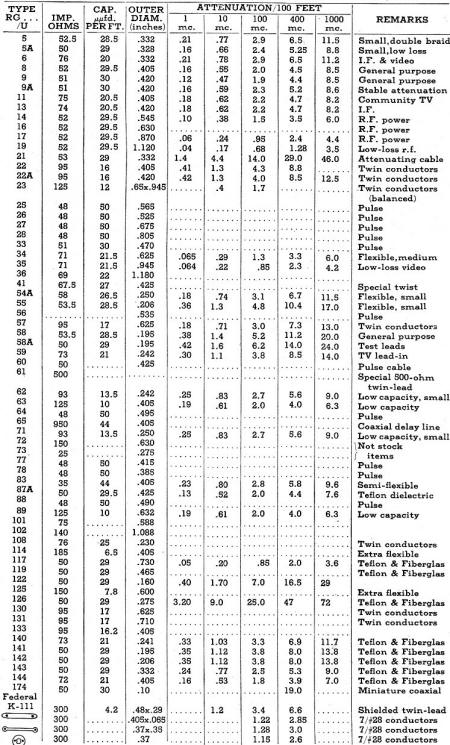|
Lots of RF transmission cable
parameter charts are available on the Internet, but what sets this one apart
is that is has entries for some of the popular 300 Ω twin-lead cables of the rooftop
television antenna era. It appeared in a 1956 issue of Radio & Television
News magazine. Mentioned in the article is the reason most TV lead-in cable
was colored brown was to help keep the sun's ultraviolet rays from penetrating
and deteriorating the plastic. Author Robert Gary claims silver coloring was also used
to reflect the UV, but I don't recall ever seeing silver twin-lead - maybe it
was a regional thing like for in the southwest. At the time, μμfd
(micro-microfarad) was commonly used rather than pF (picofarad). He also
mentions the G-Line transmission cable used by many of the Community TV
providers. See "The G-Line Antenna Lead-In,
by Leonard Lieberman, and "The "G-Line" Community TV System,"
by Robert Gary for more info."
Transmission Lines
By Robert B. Gary

This table will help you select the right wire or cable for test
leads, transmission lines, and other uses.
Whether a short piece of coaxial cable is needed as a shielded test lead for
an oscilloscope, or 10 miles of transmission line is to be selected for a community
TV system, the electrical characteristics of the various commercially available
cables are important criteria. The table presented here lists all of the most frequently-used
coaxial cables and TV twin-leads and gives their electrical characteristics.
The wires and cables in the table are listed by "RG" numbers since these represent
the only standard designations available for a great variety of manufacturer type
numbers. Some of the types are variations of a standard type; for example, one variation
may have a special outer insulation effective at low temperatures, or a metal outer
sleeve or "armor." In many instances the letter "A" or "E" follows the type number
and indicates that either a different type outer jacket or some other minor variation
exists.
The type numbers listed represent the basic, up-to-date cables manufactured by
most of the major cable suppliers.
Note that the characteristic impedances do not always fall into the standard
50 or 75 ohms expected from most diagrams. In general, such values as 48 or 53 ohms
are close enough to 50 ohms to be considered such.
The outer diameter of a cable is important because it will determine such mechanical
details as cable clamps, connector types, and feedthrough holes. The electrical
data includes the effective capacity in micromicrofarads per foot, an important
consideration in cables feeding either pulse networks or tuned circuits. The cable
for an oscilloscope probe, for example, should have minimum capacity. If the nominal
scope input capacity is 30 μμfd. without the cable and a 6-foot length of
RG 58/U is added, this in-creases the effective input capacity to more than 200 μμfd.,
which may be sufficient to distort the leading edge of a short duration pulse.
Attenuation per 100 feet is stated in decibels for the most important frequencies.
While attenuation in transmission lines becomes critical usually only in long distance
systems such as in community TV installations, even shorter lengths require some
consideration. Consider the lead-in from a 30-foot tower-mounted antenna array to
a receiver located another 120 feet from the tower. For the low-band v.h.f. stations
the attenuation with flat twin-lead (300-ohm) for the entire length would be less
than 2 db nominally. If a u.h.f. station near 500 mc. were received on this installation
the line loss alone would be over 4.5 db, Use of shielded twin-lead would double
the attenuation.
Some of the latest coaxial cable types use Teflon and Fiberglas insulation. Extremely
high temperature performance is the major advantage of these types and their greater
cost dictates their use mostly in aircraft and missile systems. New miniature coaxial
cable is also most frequently found in specialized government equipment.
Polyethylene has become the standard insulating material used in TV lead-ins.
This plastic is quite tough and moisture resistant. Unfortunately it deteriorates
rapidly under the ultraviolet rays from the sun. To overcome this drawback, most
300-ohm cable is pigmented with a brown material which keeps the ultraviolet rays
out. Recently, some suppliers have come out with a silver-colored twin-lead which
has even better resistance to the sun due to the reflective qualities of the silver-type
pigmentation. Clear plastic twin-lead should never be used on exterior installations,
but will perform satisfactorily where the sun cannot get at it.
In addition to the cables listed, most of the suppliers for community TV systems
offer special varieties, usually double shielded. One community TV system uses "G"
line, which consists only of an inner conductor and dielectric without an outer
shield. The theory behind the operation of this type of transmission line was explained
in the article, "The G-Line Antenna Lead-in," in the April, 1955, issue of Radio &
Television News. Another type of lead-in that is quite popular where long transmission
line lengths is the rule is open or "ladder" line, which consists of two solid conductors
separated by small bars of solid polyethylene.
Posted May 31, 2019
|










